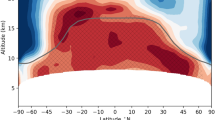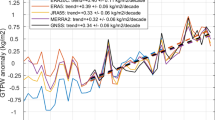Abstract
Stratospheric water vapour is a powerful greenhouse gas. The longest available record from balloon observations over Boulder, Colorado, USA shows increases in stratospheric water vapour concentrations that cannot be fully explained by observed changes in the main drivers, tropical tropopause temperatures and methane. Satellite observations could help resolve the issue, but constructing a reliable long-term data record from individual short satellite records is challenging. Here we present an approach to merge satellite data sets with the help of a chemistry–climate model nudged to observed meteorology. We use the models’ water vapour as a transfer function between data sets that overcomes issues arising from instrument drift and short overlap periods. In the lower stratosphere, our water vapour record extends back to 1988 and water vapour concentrations largely follow tropical tropopause temperatures. Lower and mid-stratospheric long-term trends are negative, and the trends from Boulder are shown not to be globally representative. In the upper stratosphere, our record extends back to 1986 and shows positive long-term trends. The altitudinal differences in the trends are explained by methane oxidation together with a strengthened lower-stratospheric and a weakened upper-stratospheric circulation inferred by this analysis. Our results call into question previous estimates of surface radiative forcing based on presumed global long-term increases in water vapour concentrations in the lower stratosphere.
This is a preview of subscription content, access via your institution
Access options
Subscribe to this journal
Receive 12 print issues and online access
$259.00 per year
only $21.58 per issue
Buy this article
- Purchase on Springer Link
- Instant access to full article PDF
Prices may be subject to local taxes which are calculated during checkout





Similar content being viewed by others
References
Fu, Q. et al. Contribution of stratospheric cooling to satellite-inferred tropospheric temperature trends. Nature 429, 55–58 (2004).
Cowtan, K. & Way, R. G. Coverage bias in the HadCRUT4 temperature series and its impact on recent temperature trends. Q. J. R. Meteorol. Soc. (2014)10.1002/qj.2297
Forster, P. M. & Shine, K. P. Stratospheric water vapour changes as a possible contributor to observed stratospheric cooling. Geophys. Res. Lett. 26, 3309–3312 (1999).
Manabe, S. & Strickler, R. F. Thermal equilibrium of the atmosphere with a convective adjustment. J. Atmos. Sci. 21, 361–385 (1964).
Forster, P. M. & Shine, K. P. Assessing the climate impact of trends in stratospheric water vapor. Geophys. Res. Lett. 29, 3309–3312 (2002).
Maycock, A. C. et al. The circulation response to idealized changes in stratospheric water vapor. J. Clim. 26, 545–561 (2012).
Riese, M. et al. Impact of uncertainties in atmospheric mixing on simulated UTLS composition and related radiative effects. J. Geophys. Res. 117, D16305 (2012).
Oltmans, S. J. et al. The increase in stratospheric water vapor from balloonborne, frostpoint hygrometer measurements at Washington, D.C., and Boulder, Colorado. Geophys. Res. Lett. 27, 3453–3456 (2000).
Scherer, M. et al. Trends and variability of midlatitude stratospheric water vapour deduced from the re-evaluated Boulder balloon series and HALOE. Atmos. Chem. Phys. 8, 1391–1402 (2008).
Hurst, D. et al. Stratospheric water vapor trends over Boulder, Colorado: Analysis of the 30 year Boulder record. J. Geophys. Res. 116, D02306 (2011).
Rohs, S. et al. Long-term changes of methane and hydrogen in the stratosphere in the period 1978–2003 and their impact on the abundance of stratospheric water vapor. J. Geophys. Res. 111, D14315 (2006).
Gettelman, A. et al. Multimodel assessment of the upper troposphere and lower stratosphere: Tropics and global trends. J. Geophys. Res. 115, D00M08 (2010).
Seidel, D. J. et al. Climatological characteristics of the tropical tropopause as revealed by radiosondes. J. Geophys. Res. 106, 7857–7878 (2001).
Wang, J. S., Seidel, D. J. & Free, M. How well do we know recent climate trends at the tropical tropopause? J. Geophys. Res. 117, D09118 (2012).
Randel, W. J. et al. Interannual changes of stratospheric water vapor and correlations with tropical tropopause temperatures. J. Atmos. Sci. 61, 2133–2148 (2004).
Fueglistaler, S. et al. The relation between atmospheric humidity and temperature trends for stratospheric water. J. Geophys. Res. 118, 1052–1074 (2013).
Randel, W. J. & Jensen, E. J. Physical processes in the tropical tropopause layer and their roles in a changing climate. Nature Geosci. 6, 169–176 (2013).
Hartmann, D. L. et al. in Climate Change 2013: The Physical Science Basis (eds Stocker, T. F. et al.) (Cambridge Univ. Press, 2013).
Fueglistaler, S. & Haynes, P. H. Control of interannual and longer-term variability of stratospheric water vapor. J. Geophys. Res. 110, D24108 (2005).
Fujiwara, M. et al. Seasonal to decadal variations of water vapor in the tropical lower stratosphere observed with balloon-borne cryogenic frost point hygrometers. J. Geophys. Res. 115, D18304 (2010).
Dee, D. P. et al. The ERA-Interim reanalysis: Configuration and performance of the data assimilation system. Q. J. R. Meteorol. Soc. 137, 553–597 (2011).
Voemel, H., David, D. E. & Smith, K. Accuracy of tropospheric and stratospheric water vapor measurements by the cryogenic frost point hygrometer: Instrumental details and observations. J. Geophys. Res. 112, D08305 (2007).
Hegglin, M. I. et al. SPARC Data Initiative: Comparisons of water vapour climatologies from international satellite limb sounders. J. Geophys. Res. 118, 11824–11846 (2013).
Simmons, A. J. et al. Estimating low-frequency variability and trends in atmospheric temperature using ERA-Interim. Q. J. R. Meteorol. Soc. 140, 329–353 (2014).
Thomason, L. W. et al. A revised water vapor product for the Stratospheric Aerosol and Gas Experiment (SAGE) II version 6.2 data set. J. Geophys. Res. 109, D06312 (2004).
Fueglistaler, S. Stepwise changes in stratospheric water vapor? J. Geophys. Res. 117, D13302 (2012).
Rosenlof, K. H. & Reid, G. C. Trends in the temperature and water vapor content of the tropical lower stratosphere: Sea surface connection. J. Geophys. Res. 113, D06107 (2008).
Randel, W. J. in The Stratosphere: Dynamics, Transport and Chemistry. (eds Polvani, S. & Waugh) 123–135 (American Geophysical Union, 2010).
Kelly, K. K. et al. Dehydration in the lower Antarctic stratosphere during late winter and early spring, 1987. J. Geophys. Res. 94, 11317–11357 (1989).
Solomon, S. et al. Contributions of stratospheric water vapor changes to decadal variation in the rate of global warming. Science 327, 1219–1222 (2010).
Jones, A. et al. Evolution of stratospheric ozone and water vapour time series studied with satellite measurements. Atmos. Chem. Phys. 9, 6055–6075 (2012).
Garfinkel, C. I., Waugh, D. W., Oman, L. D., Wang, L. & Hurwitz, M. M. Temperature trends in the tropical upper troposphere and lower stratosphere: Connections with sea surface temperatures and implications for water vapor and ozone. J. Geophys. Res. 118, 9658–9672 (2013).
Le Texier, H., Solomon, S. & Garcia, R. R. The role of molecular hydrogen and methane oxidation in the water vapor budget of the stratosphere. Q. J. R. Meteorol. Soc. 114, 281–295 (1988).
Dessler, A. E. et al. An examination of the total hydrogen budget of the lower stratosphere. Geophys. Res. Lett. 21, 2563–2566 (1994).
Ray, E. A. et al. Evidence for changes in stratospheric transport and mixing over the past three decades based on multiple data sets and tropical leaky pipe analysis. J. Geophys. Res. 115, D21304 (2010).
Engel, A. et al. Age of stratospheric air unchanged within uncertainties over the past 30 years. Nature Geosci. 2, 28–31 (2009).
Bönisch, H. et al. On the structural changes in the Brewer–Dobson circulation after 2000. Atmos. Chem. Phys. 11, 3937–3948 (2011).
Butchart, N. et al. Chemistry–climate model simulations of twenty-first century stratospheric climate and circulation changes. J. Clim. 23, 5349–5374 (2010).
McLandress, C. & Shepherd, T. G. Simulated anthropogenic changes in the Brewer–Dobson circulation, including its extension to high latitudes. J. Clim. 22, 1516–1540 (2009).
Scinocca, J. F. et al. Technical Note: The CCCma third generation AGCM and its extension into the middle atmosphere. Atmos. Chem. Phys. 8, 7055–7074 (2008).
Jensen, E. J. et al. Ice nucleation and dehydration in the tropical tropopause layer. Proc. Natl Acad. Sci. USA 110, 2041–2046 (2013).
Hegglin, M. I. et al. Multimodel assessment of the upper troposphere and lower stratosphere: Extratropics. J. Geophys. Res. 115, D00M09 (2010).
Toohey, M. et al. Characterizing sampling biases in the trace gas climatologies of the SPARC data initiative. J. Geophys. Res. 118, 11847–11862 (2013)
Damadeo, R. P. et al. SAGE version 7.0 algorithm: Application to SAGE II. Atmos. Meas. Technol. 6, 3539–3561 (2013).
De Mazière, M. et al. Validation of ACE-FTS v2.2 methane profiles from the upper troposphere to the lower mesosphere. Atmos. Chem. Phys. 8, 2421–2435 (2008).
Hurst, D. F. et al. Validation of Aura Microwave Limb Sounder stratospheric water vapor measurements by the NOAA frost point hygrometer. J. Geophys. Res. 119, 1612–1625 (2014)
Santer, B. D. et al. Statistical significance of trends and trend differences in layer-average atmospheric temperature time series. J. Geophys. Res. 105, 7337–7356 (2000).
Acknowledgements
We acknowledge the Canadian Space Agency for funding the CMAM30 project, with additional institutional support from the Canadian Centre for Climate Modelling and Analysis, who provided the model code and supercomputing time. We thank all national and international space agencies for making available their limb satellite observations for use in the SPARC Data Initiative.
Author information
Authors and Affiliations
Contributions
M.I.H. designed the methodology, performed the data analysis, and wrote the paper. D.A.P. helped with the statistical analysis, and together with J.F.S. devised and implemented the nudged model simulations. T.G.S. contributed to the interpretation and writing of the text. D.H. provided processed balloon observations. J.A., L.F., B.F., A.R., J.U., T.v.C., H.J.W., K.A.W., S.T. and K.W. processed and provided the satellite data sets.
Corresponding author
Ethics declarations
Competing interests
The authors declare no competing financial interests.
Supplementary information
Supplementary Information
Supplementary Information (PDF 1597 kb)
Rights and permissions
About this article
Cite this article
Hegglin, M., Plummer, D., Shepherd, T. et al. Vertical structure of stratospheric water vapour trends derived from merged satellite data. Nature Geosci 7, 768–776 (2014). https://doi.org/10.1038/ngeo2236
Received:
Accepted:
Published:
Issue Date:
DOI: https://doi.org/10.1038/ngeo2236
This article is cited by
-
Response of stratospheric water vapour to warming constrained by satellite observations
Nature Geoscience (2023)
-
Multi-decadal variability controls short-term stratospheric water vapor trends
Communications Earth & Environment (2023)
-
Role of Stratospheric Processes in Climate Change: Advances and Challenges
Advances in Atmospheric Sciences (2023)
-
Solar impacts on decadal variability of tropopause temperature and lower stratospheric (LS) water vapour: a mechanism through ocean–atmosphere coupling
Climate Dynamics (2019)
-
Impacts of tropical tropopause warming on the stratospheric water vapor
Climate Dynamics (2019)



